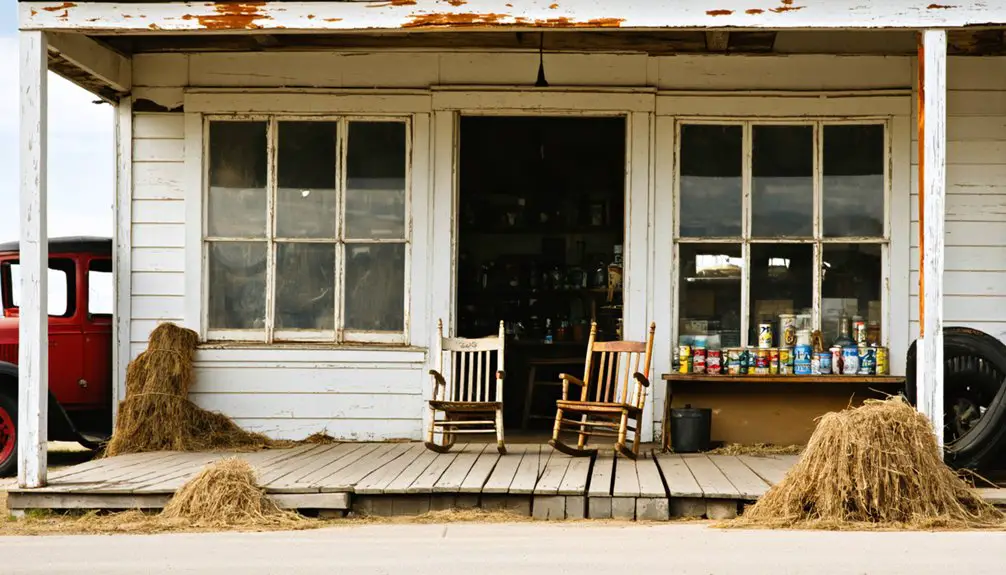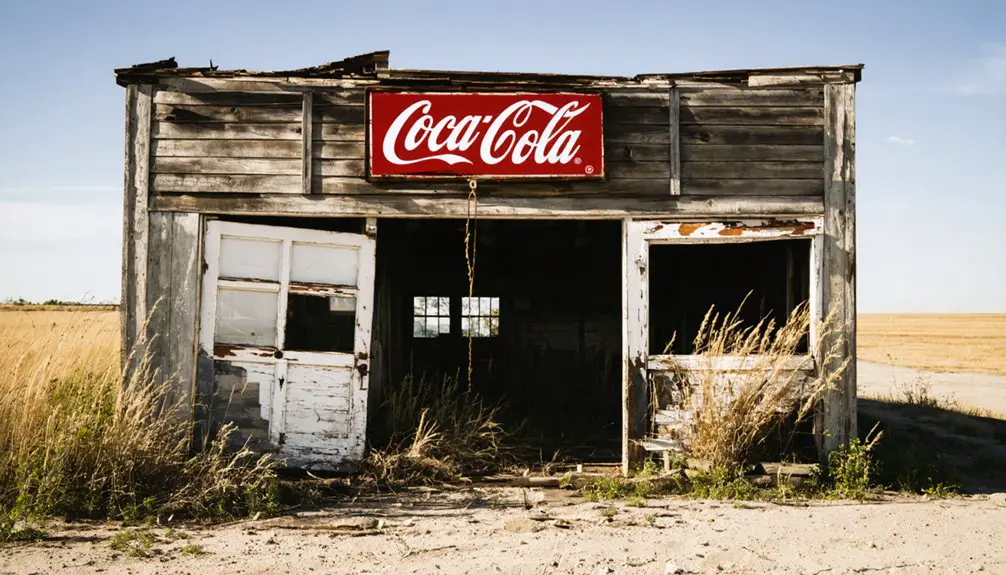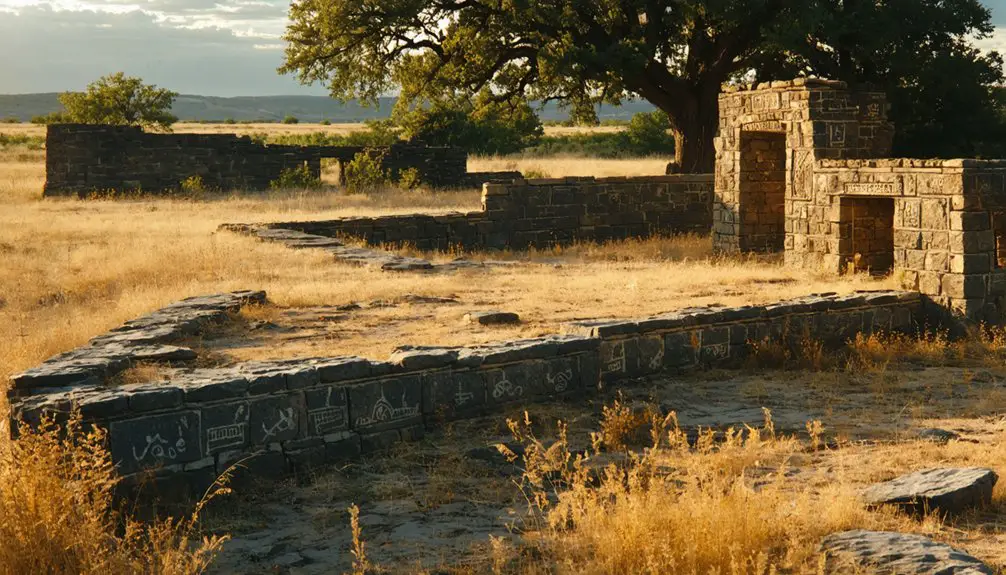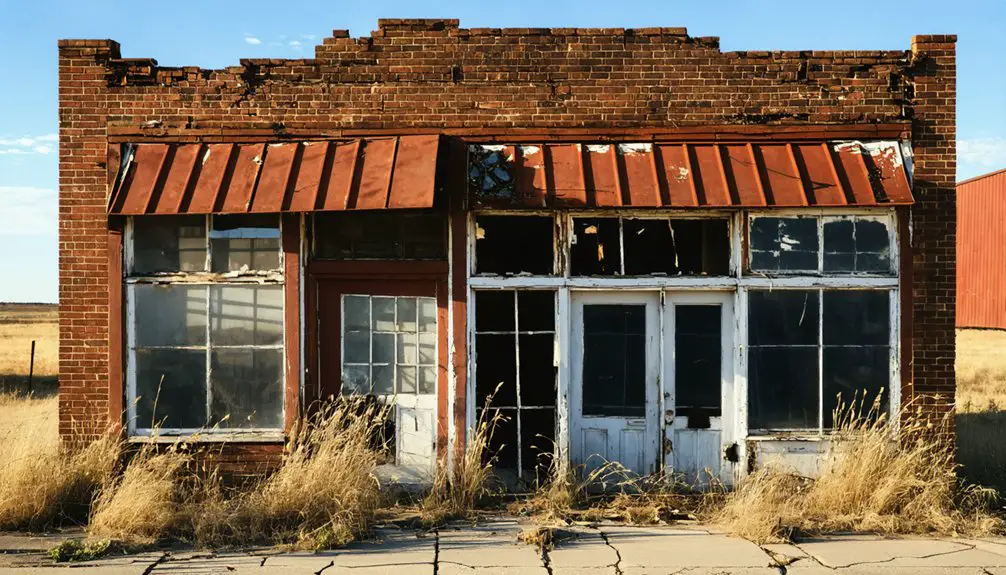You’ll find Reed, Oklahoma tucked away in Greer County along State Highway 9, where it was established in the 1890s during Oklahoma’s territorial period. Named after postmaster John Reed Graham, this agricultural settlement once supported local farmers with three general stores and a close-knit rural community. Today, it’s one of Oklahoma’s 2,000 ghost towns, with remnants that tell a deeper story of Plains tribes, farming life, and the forces that shaped America’s heartland.
Key Takeaways
- Reed was established in the 1890s as an agricultural settlement in Greer County, Oklahoma, named after postmaster John Reed Graham.
- The town served local farmers and ranchers with three general stores but declined due to lack of railroad access.
- Community life centered around schools, churches, and agricultural cooperation among settlers sharing labor and resources.
- The site is now submerged beneath Grand Lake following the construction of Grand River Dam in the 1940s.
- Reed is among Oklahoma’s 2,000 ghost towns, accessible via State Highway 9 with minimal infrastructure remaining.
The Birth of Reed: Settlement and Early Years
Although many Oklahoma settlements emerged during the territorial period, Reed’s establishment in the early 1890s reflected the broader patterns of westward expansion and development.
You’ll find Reed’s history began when settlers moved into Greer County, drawn by the promise of agricultural opportunities and regional growth. The post office’s establishment in 1892 marked Reed’s official recognition as a settlement.
Like many frontier communities, Reed faced settlement challenges typical of the era. The town developed around basic rural necessities, serving local farmers and ranchers with general stores and farming supply businesses. Similar to the estimated two thousand ghost towns that would eventually dot Oklahoma’s landscape, Reed’s future remained uncertain in its early years.
While early residents hoped the railroad would boost their community’s prospects, Reed remained a modest agricultural hub, sustained by family farms and small-scale trade rather than the industrial booms that transformed other Oklahoma towns. Much like Depew, Oklahoma, which later saw economic changes when oil was discovered in 1911, Reed’s early economy relied primarily on agriculture.
Location and Geographic Features
You’ll find Reed situated in southwestern Oklahoma’s Greer County, positioned along State Highway 9 at coordinates 34°54′2″N 99°41′44″W.
The ghost town‘s terrain features typical Great Plains characteristics with mixed prairie and gentle hills, while Jay Buckle Springs serves as a significant natural water source to the north. The area’s geography bears similarities to the landscape around the 100th Meridian, which served as a historic boundary marker between Spanish territory and the Louisiana Purchase.
Access to Reed comes primarily through State Highway 9 and local routes including North County Road 1840 and East County Road 1420. To avoid confusion with other places named Reed, this location is often referred to as Reed, Oklahoma specifically.
Physical Setting and Terrain
Along the northeastern reaches of Oklahoma lies Reed, a submerged ghost town nestled within the fertile Neosho/Grand River valley in Mayes County.
You’ll find this once-thriving site beneath the waters of Grand Lake, created by the Grand River Dam in the 1940s. Before its submergence, Reed’s landscape featured multiple earthen mounds rising above the valley’s gradual slopes, surrounded by mixed hardwood forests and tributary streams. Like other ghost towns of Oklahoma, Reed now serves as a reminder of the region’s dynamic past.
The area’s natural resources and ecological diversity made it an ideal settlement location. Initial excavations of the site by the Oklahoma Historical Society took place in 1925. The rich floodplains supported agriculture, while the surrounding terrain provided abundant game, ceramic materials, and metal sources.
The rivers served as crucial transportation routes, connecting Reed to broader trade networks. Today, the original terrain lies underwater, transformed from an archaeological treasure into a recreational lake setting.
Transportation Access Routes
Since the construction of State Highway 9, Reed’s primary access has centered on this east-west thoroughfare running through western Oklahoma’s Greer County.
You’ll find the ghost town at coordinates 34.90056°N, 99.69556°W, where Highway 9 intersects with North County Road 1840.
While transportation challenges persist due to Reed’s remote location near the Texas border, you’ll discover several access improvements through the county road network.
East County Road 1420 connects you to historical sites like Jay Buckle Springs, while other local roads lead to surrounding surrounding ranches and natural features.
Without rail service or public transit, you’ll need to rely on private vehicles to reach Reed.
Keep in mind that seasonal weather can affect road conditions, particularly on less-maintained county routes.
Like many locations along Route 66’s ghost towns, Reed represents a piece of decaying mid-century Americana frozen in time.
Regional Water Features
While Reed sits within the broader Red River watershed of southwestern Oklahoma, the ghost town‘s immediate vicinity lacks major bodies of water.
You’ll find numerous small creeks and drainage tributaries flowing southward toward the Red River, which forms the Oklahoma-Texas border. Water availability varies throughout the year, with seasonal streams often drying up during summer months. Unlike the dangerous situation in Picher where toxic chat piles contaminated local waterways, Reed’s water sources remain relatively unaffected by industrial pollution.
Unlike some Oklahoma ghost towns that were submerged under man-made lakes, Reed remains on dry ground. This contrasts with towns like Washunga and Uncas that disappeared beneath Kaw Lake.
The surrounding terrain features flat to gently rolling plains at elevations between 1,200 and 1,400 feet above sea level.
Any water features you’ll encounter near Reed today are primarily artificial stock tanks and small ponds serving local agricultural needs, as the region’s hydrology supports mixed farming and ranching operations.
Economic Rise and Fall
Established in 1892 with its first post office, Reed initially flourished as an essential service center for Greer County’s growing agricultural community. Named after postmaster John Reed Graham, the town served local farmers and ranchers while maintaining cultural influences through its school, church, and community gatherings.
You’ll find Reed’s economic challenges began to mount as it missed vital development opportunities. Without railroad access or major transportation routes, the town couldn’t compete with better-connected communities. The mechanization of farming and rural population decline dealt additional blows to Reed’s sustainability. The town’s scattered dilapidated buildings stand as silent reminders of its economic downturn.
Unlike some Oklahoma towns that struck oil or found other resources, Reed couldn’t diversify its economy. Today, abandoned buildings, including a school with desks still in place and a silent organ, tell the story of a once-vibrant community that couldn’t overcome these economic hurdles.
Daily Life in Early Reed

If you’d lived in early Reed, you’d have spent your days working alongside extended family on quarter-section farms, relying on neighbors for shared labor and resources typical of Oklahoma’s rural settlements.
You’d have traveled by horse and foot to conduct basic commerce, primarily through bartering agricultural goods with nearby homesteaders.
Community gatherings centered around practical activities like barn-raisings and crop harvests, which served both social and economic purposes in the close-knit farming settlement.
Pioneer Family Routines
As pioneer families carved out their existence in early Reed, daily life centered around basic survival in harsh conditions.
You’d find pioneer routines revolving around constant shelter maintenance, with families patching leaky roofs using canvas or oxhide. Family dynamics meant sharing cramped log cabins, often without proper doors or windows, while coordinating crucial tasks like hunting and food preservation.
You’d spend your days managing scarce resources, caring for essential oxen, and working alongside neighboring families to improve survival odds.
With communities typically comprising 19 men, 12 women, and 29 children per 60 settlers, everyone had specific roles. Adults and older children handled physically demanding tasks, while others supervised toddlers and maintained makeshift shelters.
Resource sharing became necessary, creating a network of mutual support through lending and labor exchange.
Early Commerce Activities
The bustling commerce of early Reed revolved around three essential general stores that served as the settlement’s economic backbone before 1900.
You’d find these stores stocked with farming supplies, food staples, and household necessities, while their owners managed complex barter systems through credit arrangements with local families.
The market dynamics centered heavily on cotton production, with streets often blanketed in cotton fibers during busy trading days.
You could witness farmers bringing their harvest to the local gin for processing, while blacksmiths and craftsmen operated nearby shops, keeping agricultural equipment running.
The arrival of the railroad transformed Reed’s commerce, shifting business operations closer to the tracks.
The post office, established in Reed’s store, connected you to wider trade networks, facilitating orders beyond local sources.
Community Social Gatherings
Life in early Reed centered around vibrant community gatherings, where you’d find social bonds forged through both formal and informal venues. The local church served as the heart of social cohesion, hosting not just Sunday services but also festivals and community meetings.
You’d likely spend time at the general store, catching up on local news while picking up supplies.
Throughout the year, you’d join your neighbors for seasonal celebrations, harvest festivals, and holiday events like Fourth of July picnics. Family reunions and weddings brought together extended families and townspeople alike.
Community traditions thrived through cooperative activities – from barn raising to crop harvesting – where neighbors helped neighbors. These gatherings, whether at the town hall, church, or outdoor venues, kept Reed’s social fabric strong through shared experiences and mutual support.
The Path to Abandonment

While Reed, Oklahoma once thrived as a bustling community along major travel routes, its descent into abandonment followed a predictable pattern seen across many Oklahoma ghost towns.
You’ll find the town’s decline accelerated when Interstate 40 was built just a mile east, diverting essential traveler traffic and commerce away from local businesses.
The population migration hit hard as younger residents sought opportunities in urban areas, leaving an aging community unable to sustain basic services.
Reed’s economic vulnerability became apparent as it relied heavily on passing travelers and lacked diverse industries to maintain stability.
By the 1970s, you could witness the final stages of decline – closed shops, shuttered schools, and abandoned post offices marking the end of what was once a promising settlement.
The town’s story reflects the broader pattern of resource-dependent communities throughout Oklahoma.
Architectural Remains and Historic Structures
Scattered across Reed’s abandoned landscape, you’ll find architectural remnants that tell the story of a once-thriving Oklahoma community. The town’s architectural styles range from simple wood-frame houses to Gothic Revival churches, reflecting the practical needs of frontier life.
While most structures have succumbed to decades of neglect, surviving buildings offer glimpses into early 20th-century construction techniques and local materials.
- Wood-frame homes with clapboard siding stand as silent witnesses to residential life.
- Derelict commercial buildings reveal multi-purpose designs that once housed general stores and post offices.
- Church ruins showcase simplified Gothic Revival elements common to rural Oklahoma.
- Transportation-related structures, including old rail depot remains and roadside service stations, mark Reed’s connection to historic travel routes.
Reed’s Connection to Native American Heritage

Near Reed’s abandoned townsite, you’ll find remnants of ceremonial mounds that once served as gathering places for Plains tribes including the Pawnee.
Archaeological evidence suggests the area was part of extensive Native American trade networks, with artifacts like pottery shards and tool fragments scattered across local fields.
These physical traces connect Reed’s history to centuries of indigenous presence, when the region served as a crossroads for different tribal communities moving between seasonal camps and settlements.
Ceremonial Mounds Near Reed
Located along the Neosho/Grand River valley, the Reed site features multiple ceremonial mounds dating primarily to the 13th century.
Though now submerged beneath Grand Lake, this site held tremendous ceremonial significance within the ancient Mississippian cultural sphere, sharing connections with the nearby Spiro Mounds complex.
- The mounds were meticulously constructed by layering dirt in baskets, creating elevated platforms for temples and elite residences.
- Excavations in 1925 and the 1940s revealed sheet copper items, decorated earspools, and both local and imported ceramic vessels.
- The site functioned as part of a vast ceremonial network stretching from the Rocky Mountains to the Great Lakes.
- Religious ceremonies at Reed aligned with solar cycles and seasonal changes, drawing thousands for multi-day spiritual gatherings.
Trade Networks and Artifacts
Through an extensive network of waterways and overland paths, Reed emerged as a nexus within Native American trade routes that connected tribes across Oklahoma and beyond.
You’ll find evidence of trade routes linking the Caddo, Wichita, and Plains tribes through artifacts discovered near the Arkansas and Canadian Rivers. These precious items include shell beads from the Gulf Coast, copper from the Great Lakes, and obsidian from distant quarries.
When French fur traders arrived in the 18th century, they integrated Reed’s area into broader commerce networks.
While not a major trading post itself, Reed’s strategic location near Fort Gibson and Creek Agency positioned it within crucial exchange corridors.
You can trace this heritage through recovered artifacts like glass beads, metal tools, and woven textiles that showcase the blending of Native and European cultures.
Notable Events and Local Stories
Among Reed’s most compelling historical narratives stands the unsettling tale of a widow’s desperate attempts to resurrect her husband from the town’s burial plot of 1,100 graves.
Her haunting chants, inscribed on his tombstone, led to multiple exhumations until the town encased his body in concrete. In response, she allegedly cursed the community, leaving an ominous inscription that still sparks local debate.
- The town’s notable deaths intertwined with bootlegging lore from nearby Beer City, where smuggling routes and buried treasure tales emerged.
- Marshal Bush’s death highlighted the region’s lawless nature.
- Mysterious disappearances linked to bootlegging rivalries created enduring legends.
- Paranormal enthusiasts continue investigating the cemetery’s reported supernatural activity, drawn by the widow’s curse and unexplained phenomena.
Legacy in Oklahoma’s Ghost Town History

As one of Oklahoma’s 2,000 ghost towns, Reed stands as a monument to the complex forces that shaped the state’s rural landscape during the late 19th and early 20th centuries.
You’ll find in Reed’s story a familiar pattern of ghost town dynamics – a settlement that rose with agricultural promise but gradually declined as economic transformations reshaped the region.
Unlike fully abandoned towns like Picher, Reed’s semi-deserted status offers you a unique window into Oklahoma’s rural evolution.
The town’s remaining structures tell the tale of shifting transportation routes, changing agricultural practices, and the broader economic upheavals that transformed countless small communities.
As part of Oklahoma’s settlement geography, Reed’s legacy helps you understand how external forces continue to influence the ebb and flow of rural populations across the state.
Modern-Day Site Exploration and Access
When exploring Reed’s ghost town site in Greer County, you’ll find it positioned along State Highway 9 and North County Road 1840 at coordinates 34°54′2″N 99°41′44″W.
For successful ghost town exploration in this remote location, you’ll need to rely on private transportation, as public options aren’t available in this rural area.
- Access the site via State Highway 9, then navigate local roads including North County Road 1840 and East County Road 1420.
- Bring appropriate vehicles suited for rural conditions, as some county roads remain unpaved.
- Obtain permission before venturing onto private property, as most surrounding land isn’t public access.
- Plan your rural site access carefully, considering there’s minimal emergency infrastructure and no visitor facilities in the immediate area.
Frequently Asked Questions
Were Any Movies or Documentaries Ever Filmed in Reed, Oklahoma?
You won’t find any documented film history or documentary locations in Reed. While Oklahoma’s ghost towns have attracted filmmakers, there’s no evidence of movies being shot in this particular spot.
What Happened to the Last Remaining Family to Leave Reed?
Like 95% of Oklahoma’s ghost towns, you won’t find records of the last family’s final departure from Reed around 1975. They likely moved to larger communities for better opportunities.
Are There Any Paranormal or Ghost Stories Associated With Reed?
You won’t find documented ghost sightings or haunted history connected to Reed. Unlike other Oklahoma ghost towns that attract paranormal interest, no specific supernatural stories have been recorded about this location.
Did Any Famous People Originally Come From Reed, Oklahoma?
You won’t find any famous residents who came from Reed. While the area’s notable landmarks include prehistoric Native American mounds, there’s no documented evidence of nationally recognized people emerging from this community.
Are There Any Surviving Photographs of Reed During Its Peak Years?
While you might expect historical archives or vintage postcards to preserve Reed’s heyday, there’s no conclusive evidence of surviving photographs from the town’s peak years in public collections or databases.
References
- https://www.routemagazine.us/stories/loneliest-places-along-route-66
- https://en.wikipedia.org/wiki/List_of_ghost_towns_in_Oklahoma
- https://web.saumag.edu/aas/2012/09/10/archeology-of-the-reed-site-ceremonialism-in-oklahoma/
- https://www.okhistory.org/publications/enc/entry?entry=GH002
- https://kids.kiddle.co/List_of_ghost_towns_in_Oklahoma
- https://okmag.com/blog/a-ghostly-site/
- https://en.wikipedia.org/wiki/Reed
- https://kellycodetectors.com/content/pdf/site_locator_books/OK.pdf
- https://oklahoma.gov/content/dam/ok/en/deq/documents/water-division/2004_OK_IR.pdf
- https://www.okhistory.org/about/markers.php?pageno=1&name=%%&county=%%&topic=%%%&action=Search



